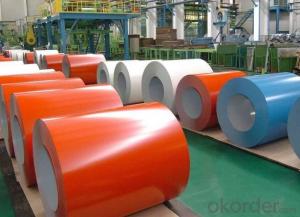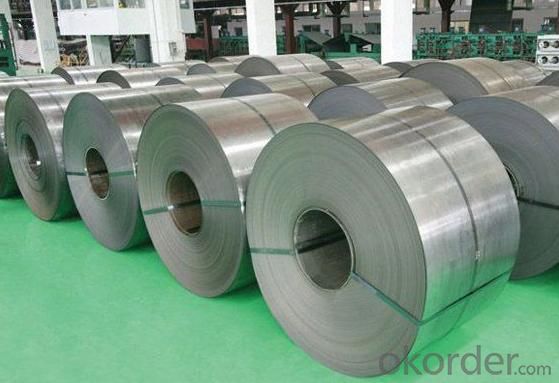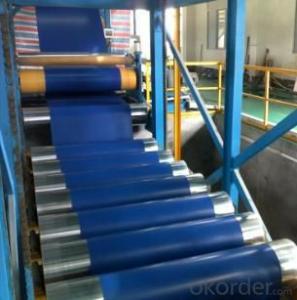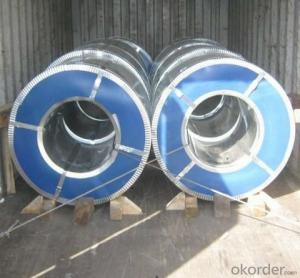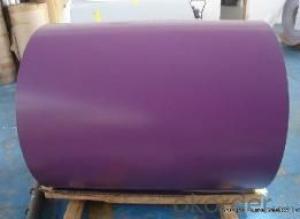Colored Coated Stainless Zinc Steel Coils of Building Materials
- Loading Port:
- Shanghai
- Payment Terms:
- TT OR LC
- Min Order Qty:
- 30 m.t.
- Supply Capability:
- 20000 m.t./month
OKorder Service Pledge
Quality Product, Order Online Tracking, Timely Delivery
OKorder Financial Service
Credit Rating, Credit Services, Credit Purchasing
You Might Also Like
Basic Info.
Surface Treatment:Coated
Grade:Galvanized or Gavalume
Width:914, 1000, 1200, 1219, 1220, 1250
Treatment:Galvanized or Gavalume
Color:Ral Standard, or Buyer′s Sample Color
Zinc Coating:40-150GSM
Length:up to The Thickness
Base Material:Steel
Lacquer:Top Side15-25 Micro, Back Side 5 Micro
Surface:Passivation Unoiled Free Spangle Passivated
Export Markets:Global
Additional Info.
Trademark:STW or OEM
Packing:Export Seaworthy Packing
Standard:JIS G3312 / CGCC
Production Capacity:20000 Metric Tons/Month
Specifications:
| Zinc Coating | 60-275g( as required) |
| Thickness Range | 0.14-1.5mm |
| Coil Inner Diameter | 508mm |
| Coil weight | 3-5MT(as required) |
| Surface | Regular/mini/zero spangle, chromated, skin pass, dry etc. |
| Width range | 600-1250mm(900mm, 1215mm, 1250mm, 1000mm the most common) |
| Applications | With excellent cold bending molded manufacturablity, good decoration effect, strong anti-corrosion ability, galvanized steel coils and sheets are also pollution-free and easily recycled. Accordingly, they can be used as final products and basic plates of color coated steel coils and widely applied in construction, home appliances, decoration, ect. |
- Q: What is the difference between galvanized and galvalume steel coils?
- Galvanized steel coils are coated with a layer of zinc, which provides protection against corrosion. On the other hand, galvalume steel coils are coated with a combination of zinc and aluminum, offering enhanced corrosion resistance and better heat reflectivity. Additionally, galvalume steel coils have a longer lifespan and superior performance in harsh environments compared to galvanized steel coils.
- Q: How are steel coils unloaded from a truck?
- Typically, specific equipment and a well-coordinated process are utilized to unload steel coils from a truck. To ensure the safe and efficient removal of the coils, the unloading process consists of multiple steps. First, a forklift or crane is commonly employed to reach into the truck bed and secure the steel coil. The operator of the forklift or crane carefully positions the lifting apparatus underneath the coil, ensuring that it is centered and balanced. Once the steel coil is securely fastened, the forklift or crane gradually raises it out of the truck bed while maintaining stability. The operator must exercise caution and consider factors such as the weight and dimensions of the coil to prevent any accidents or damage. After the steel coil is lifted out of the truck, it is typically placed onto a designated area, such as a flatbed trailer, storage rack, or directly onto the ground. If placed on the ground, wooden blocks or rubber mats are often utilized as protective measures to prevent any damage to the coil or the surface it is placed on. In certain instances, a specialized coil trailer equipped with hydraulic systems may be used to unload the steel coils. This method is particularly beneficial for unloading larger and heavier coils, as it allows for the tilting of the trailer bed and rolling off the coil. In conclusion, unloading steel coils from a truck necessitates skilled operators, appropriate lifting equipment, and adherence to safety protocols. It is crucial to meticulously follow these steps to ensure the safe and efficient unloading of steel coils.
- Q: How are steel coils used in the production of industrial equipment?
- Steel coils are used in the production of industrial equipment as their versatile and durable nature makes them ideal for fabricating various components such as frames, structures, panels, and parts. These coils are processed and shaped into the required size and shape, allowing manufacturers to create sturdy and reliable equipment that can withstand heavy use and harsh environments.
- Q: How are steel coils inspected for formability?
- Steel coils are typically inspected for formability through a combination of visual inspection, mechanical testing, and laboratory analysis. Visual inspection involves examining the surface of the coil for any visible defects such as scratches, dents, or deformities that could affect its formability. This is usually done by trained personnel who carefully inspect the entire surface of the coil. Mechanical testing is also commonly employed to assess the formability of steel coils. This can include conducting physical tests such as tensile testing, where a sample is subjected to controlled forces to measure its strength and elongation properties. This helps determine if the steel has the necessary ductility and strength to be formed into the desired shape without cracking or breaking. Additionally, laboratory analysis is often conducted to assess the chemical composition and microstructure of the steel. This involves taking small samples from the steel coil and analyzing them using techniques such as spectroscopy and microscopy. These analyses can provide valuable insights into the steel's composition, grain structure, and other characteristics that can impact its formability. Overall, a combination of visual inspection, mechanical testing, and laboratory analysis is used to ensure that steel coils meet the required formability standards. This comprehensive approach helps identify any potential issues or defects that could affect the performance and reliability of the steel when it is formed into its intended shape.
- Q: How are steel coils inspected for chemical composition using spectroscopy?
- Steel coils can be inspected for their chemical composition using spectroscopy, specifically techniques like X-ray fluorescence (XRF) or laser-induced breakdown spectroscopy (LIBS). In XRF, an X-ray beam is directed onto the surface of the steel coil, causing the atoms in the sample to emit characteristic X-ray fluorescence radiation. By analyzing the energy and intensity of these emitted X-rays, the elemental composition of the steel can be determined. XRF is a non-destructive and rapid technique, allowing for quick and accurate assessment of the chemical composition of the steel coil. LIBS, on the other hand, involves focusing a laser beam onto the surface of the steel coil, creating a high-temperature plasma. The plasma emits light, which is then collected and analyzed using a spectrometer. The emitted light contains characteristic atomic and ionic emissions, allowing the identification and quantification of various elements present in the steel. LIBS is also a non-destructive technique, providing real-time results and requiring minimal sample preparation. Both XRF and LIBS offer advantages in terms of speed, non-destructiveness, and ease of use for inspecting steel coils for their chemical composition. These spectroscopic techniques play a crucial role in quality control and assurance, ensuring that the steel meets the required specifications and standards for various industrial applications.
- Q: Aluminum alloy rolling doors and color steel shutter door that good
- Hello, the shutter door material mainly galvanized steel plate, color steel plate, aluminum alloy, stainless steel, PVC soft board, PVC soft door curtain.
- Q: I completed the missions in broken steel like: the one of the rangers, the one of vault 101, the one of the enclave, and several others.are there any more INTERESTING missions?
- Nah the rest really aren't that intresting. i usually just walk around looking for missions............ and caps
- Q: What are the advantages of using pre-painted steel coils?
- There are several advantages to using pre-painted steel coils. Firstly, pre-painted steel coils have a protective coating applied during the manufacturing process, which makes them resistant to corrosion and increases their lifespan. Additionally, the pre-painted coating provides a smooth and aesthetically appealing finish, eliminating the need for further painting or finishing. This saves time and money on additional coatings or treatments. Moreover, pre-painted steel coils are available in a wide range of colors and finishes, allowing for greater design flexibility and customization. Lastly, pre-painted steel coils are easy to install, lightweight, and have excellent durability, making them an ideal choice for various applications in construction, automotive, and other industries.
- Q: What are the different methods of coil packaging for steel coils?
- There are several methods of coil packaging for steel coils, including stretch wrapping, strapping, banding, and shrink wrapping. Stretch wrapping involves wrapping a stretch film tightly around the coil to secure it. Strapping and banding use metal or plastic straps to hold the coils together. Shrink wrapping involves covering the coil with a plastic film that shrinks when heated, providing a tight and protective cover. These methods help to protect the coils during storage, transportation, and handling, ensuring they remain in good condition.
- Q: Steel, Sturm, and Kitiara are in a series called the Dragonlance Chronicles.
- Steel Brightblade
Send your message to us
Colored Coated Stainless Zinc Steel Coils of Building Materials
- Loading Port:
- Shanghai
- Payment Terms:
- TT OR LC
- Min Order Qty:
- 30 m.t.
- Supply Capability:
- 20000 m.t./month
OKorder Service Pledge
Quality Product, Order Online Tracking, Timely Delivery
OKorder Financial Service
Credit Rating, Credit Services, Credit Purchasing
Similar products
Hot products
Hot Searches
Related keywords
